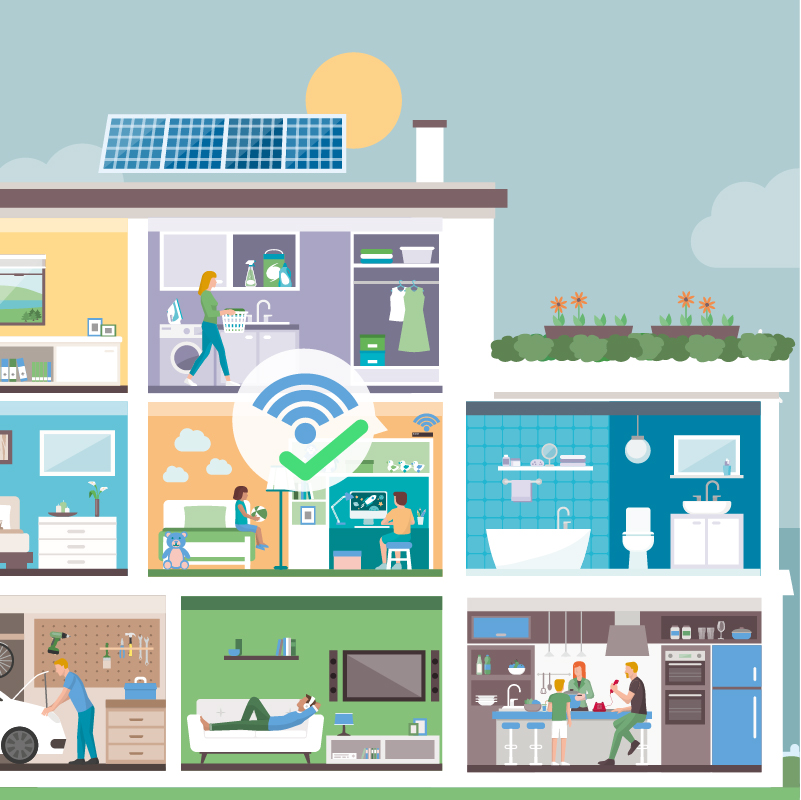User Experience
When it comes to connecting your devices to the internet at home, you can choose between a wired and a WiFi connection. This section provides a brief explanation of these two types of connections and provides some tips that will help you enhance your internet quality of service when connected via a WiFi connection.

Wired Connection
A wired connection uses a cable to connect your device/s to your service provider’s modem.
To connect your device to the internet you need an Ethernet cable….
…..which is connected from one end to the Ethernet port on the modem provided by your Internet Service Provider ‘ISP’
and from the other end to the Ethernet port on your device.
A number of devices such as tablets and mobiles can only be connected to the internet by means of a mobile connection such as 3G and 4G provided by your mobile network operator, or through a WiFi network which you may install at home, or which is found publicly available. This guide focuses solely on WiFi installations.
WiFi Connection
A WiFi connection enables you to access the internet whilst moving around freely within the area of the network. A WiFi connection is typically available indoors and is intended to provide coverage within a building.
A typical home set-up consists of a single WiFi enabled modem intended to provide a signal to a large extent of your home. In some cases, you might need to install multiple WiFi access points, however special precautions are necessary to ensure that these do not interfere with each other and thus restrict the coverage and/or degrade the performance of the setup.
To set-up your home WiFi system, you will need to have a wireless access point. Most fixed ISPs provide their customers with a WiFi enabled modem.
Follow your WiFi enabled modem's guide and setup your WiFi network name (SSID) and password (WPA). Make sure you set your WiFi enabled modem to operate in the correct region, i.e. either Malta or Europe.
However, you should note that whilst setting up a WiFi network is not so difficult and most non-technical users are able to self-install a WiFi connection at home, some scenarios which are typically complex may still require the assistance of a qualified technician.
Tips to improve your WiFi connection
If you are experiencing a poor internet connection when connected via a WiFi network, you need to first see whether the problem is originating from the connection provided by your ISP. All you need to do is test your internet connection through a wired connection. If this works, then it is possible that the problem relates to the WiFi setup. The below tips may help you improve your internet user experience whilst using a WiFi connection.
- Place the WiFi enabled modem in a central location of your home, preferably in an open space, such as a hallway. This will make your WiFi enabled modem equally accessible from all parts of the house and thus, all areas should be equally covered.
- Place the WiFi enabled modem in a high position such as on top of a cabinet or a shelf. This will help the WiFi signal to achieve the maximum coverage possible.
- Do not place the WiFi enabled modem inside cupboards or in enclosed shelves since such furniture would absorb and hence reduce or block the WiFi signal.
- Try not to place the WiFi enabled modem near windows so that you maximise the signal within your house, rather than waste a portion of it outdoors.
- Try not to place the WiFi enabled modem in an area surrounded by metal objects, as these may interact with your signal.
If you intend to upgrade the firmware of the WiFi access point or any of its components such as its antenna to, for example increase your WiFi coverage, please make sure that such changes will not alter the radio frequency transmission paratmeters of the system. This is important to ensure that your system will remain compliant with the current Regulations. If in doubt, you may wish to consult with the Authority or a qualified technician.
To increase your wireless coverage, you can also consider the installation of multiple WiFi access points. These may take the form of a WiFi router, or a WiFi extender, amongst others. The installation of these devices is tailored to the property they need to cover and, in some cases, the assistance of a technician is required to optimise the placement and configuration of each device to ensure that these do not interfere with each other.
Security
When setting up a WiFi connection, you must ensure to implement certain security measures, such as using strong encryption and changing the default passwords of the WiFi enabled modem. Standard practice related to the complexity of passwords and their protection are also applicable to WiFi networks. It is also advisable to maintain all the software of devices using the network and setting up the network updated using the latest vendor updates. It is also equally important to make appropriate use of firewalls and other standard safeguards to protect the home network. Such measures help to reduce the risk of anybody else in the vicinity being able to access your home network, potentially harming your network and possibly even your reputation if illicit activities are carried out using your connection.





